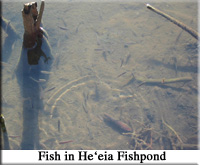 |
|
|
The Hawaiian fishpond was primarily a grazing area for fish. Therefore, maintaining the growth of food source for the young fish, algae, was fairly important. To increase the cultivation of algae, fishponds were designed to be only two to three feet so that sunshine could penetrate the water to provide energy for growth (Henry, 1993). He'eia
was built in an ideal location since fresh water flowed into the fishpond
from He'eia Stream and salt water flowed into the fishpond from Kane'ohe
Bay. This type of environment provided a The
most popular types of fish kept in the ponds were mullet ('ama 'ama)
and milkfish (awa). The young fish (pua) would enter
the pond through the small openings of the makaha. To increase
and ensure a healthy supply of desired fish, sometimes pua
of various types of fish were captured outside of the fishpond and brought
into the fishpond. Within the fishpond walls, pua would feed
on algae and grow too large to escape through the makaha (Henry,
1993).
|
| |
||
|
Site maintained by . |
||

